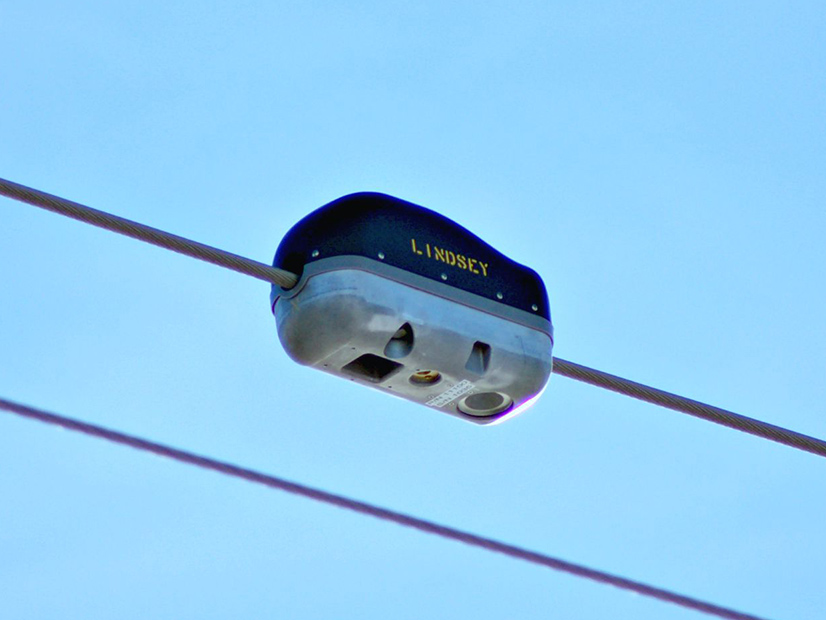Utility representatives at the American Clean Power Association’s virtual CLEANPOWER 2021 Conference & Exhibition last week agreed that so-called grid-enhancing technologies (GETs) would help facilitate increased interconnection and transmission of renewable power.
But they admitted that without any financial incentives, either from FERC or by congressional mandate, their companies were unlikely to make the huge investments needed to deploy the devices, which include dynamic line ratings (DLRs), advanced power control and ambient-adjusted ratings (AARs).
GETs provide a quicker, cheaper alternative to building more transmission lines. The technologies monitor the conditions of a line — which can include temperature, wind speed and precipitation, depending on the device — and adjust its rating accordingly, allowing for more electricity to flow more often than if its rating remained constant.
“We’re looking at the fact that the states that National Grid is operating in in the Northeast U.S. have very ambitious decarbonization targets,” Terron Hill, the company’s director of transmission network strategy, said during a conference panel Wednesday. “And at the end of the day, we can’t build the transmission fast enough. So [GETs are] all about how we capture that benefit or capacity that already exists in our system that we can utilize to get renewables onto the grid faster.”
The panel opened with a presentation by Jay Caspary — former head of transmission development at SPP, now vice president at consultancy Grid Strategies — on a report released in February by the WATT Coalition titled “Unlocking the Queue.” The report found that GETs could double the amount of renewable generation in SPP’s queue that interconnects by 2025 by alleviating transmission constraints in Kansas and Oklahoma. (See Report: US Needs Grid-enhancing Technologies Now.)
“GETs focus on operational improvements and can be implemented quicker and at a lower cost than traditional transmission technologies,” according to the report.
But “most utilities are a little bit risk-averse and a little bit change-averse,” Smart Wires’ Mark Freyman said. “It’s difficult to get them to try something new.”
Hill agreed. Deploying GETs by themselves may be quicker and cheaper than building transmission, but National Grid has been building transmission since its founding, he said. The devices still require utilities to update their operational and planning models and train their workforce in a new set of skills.
Amanda King, director of strategic transmission planning at Xcel Energy, echoed that sentiment. Training transmission operators “isn’t a minimal thing. We can say, ‘yes, we’re going ahead with these technologies’ … but to be realistic, the transmission planning models currently aren’t built for dynamic line ratings, for example, and the operators aren’t trained to operate that in real-time, on the fly. … Those are non-trivial items that take a while.”
So “we need FERC to give us the right incentives to” deploy GETs, Hill said, “because now you’re asking us to take on a whole bunch more risks. Because if something goes wrong, it’s the utility that has a violation. … I’m not saying that we shouldn’t do it, but we need to have the right incentives in order to give us that motivation.”
New FERC Initiative Incoming?
Elizabeth Salerno, economic adviser to FERC Chairman Richard Glick, pointed to the commission’s proposal to require all transmission providers to implement seasonal and ambient-adjusted ratings on their lines. (See FERC Proposes Requiring Variable Tx Line Ratings.)
She also noted that FERC is investigating what barriers exist to implementing GETs and how to properly incent their deployment. A workshop on performance-based ratemaking is scheduled for September, which is part of a docket that saw FERC propose to decrease its RTO participation adder. (See related story, TOs Won’t Give up RTO Adder Without a Fight.)
“We recognize it takes a long time for transmission to be built,” Glick told ACP CEO Heather Zichal on Thursday. “Even if we had the greatest planning processes, even if we had the best cost allocation approach and even if we had a much better approach to siting at the state level, it’s still going take a number of years before this new transmission is built, so we need to figure out a way to better use our existing transmission capacity.”
Still, getting more transmission built remains his highest priority. “If we’re going to meet the very ambitious targets set both by the Biden administration and a number of states in terms of reducing greenhouse gas emissions, we’re only going to do so if we massively build out electric transmission capacity,” he said.
FERC’s agenda for its upcoming open meeting, released Thursday, lists two new dockets: “Joint Federal-State Task Force on Electric Transmission” (AD21-15) and “State Voluntary Agreements to Plan and Pay for Transmission Facilities” (PL21-5).
With the first, “FERC appears poised to announce a new initiative to work formally with states to address potential challenges to transmission projects,” according to ClearView Energy Partners. The second policy statement docket “appears to be a step toward the commission formalizing new options for planning transmission cost allocation for offshore wind. However, we think it will be broader than offshore wind, as best-practices and a framework for resolving stakeholder concerns regarding multistate regional projects could be useful as more states pursue decarbonization strategies with prescriptive programs that drive certain types of clean generating resources.”




